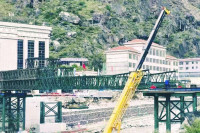Money
NRB defends commercial banks operating as cartels
In a strange turn of events, the Nepal Rastra Bank (NRB), the central bank, has started defending commercial banks that are breaching the core principle of market economy by regulating deposit rates, stating “the move will stabilise the market at a time when there is severe shortage of loanable funds”.
In a strange turn of events, the Nepal Rastra Bank (NRB), the central bank, has started defending commercial banks that are breaching the core principle of market economy by regulating deposit rates, stating “the move will stabilise the market at a time when there is severe shortage of loanable funds”.
A meeting of the Nepal Bankers’ Association, an umbrella body of commercial banks, held on Friday decided not to offer interest of over 8 percent to depositors who park funds in savings deposit accounts. All 28 commercial banks have agreed to heed this call, a banker, who took part in the meeting, said on condition of anonymity. The new decree will come into effect on Sunday, which means some of the banks that are offering savings deposit rate of up 10 percent will have to reduce the interest.
This is expected to hurt retail depositors as they are the ones who park money in savings deposit accounts. However, bankers claim depositors will not be at the losing end, as inflation currently stands at 4 percent.
The latest move comes at a time when commercial banks have entered into, what they call, “gentlemen’s agreement”, that bars any bank from offering interest of over 11 percent on funds deposited in fixed deposit accounts.
This practice of controlling deposit rate goes against the principle of market economy, which says supply and demand in the market should guide all the prices.
Surprisingly, the central bank, which deregulated interest rate regime in the early 1990s, is supporting the move made by commercial banks.
“Runaway deposit rates would only put pressure on lending rates, which would hit borrowers and prevent private sector growth,” said central bank Deputy Governor Chinta Mani Siwakoti. “So, the move made by commercial banks will bring some stability in interest rates.”
But there are others who say the central bank should have allowed market to determine interest rates, as higher deposit rates could have attracted funds from unproductive sectors, such as stock market and real estate. This flow of funds, according to them, would have gradually exerted downward pressure on deposit rates and prevented lending rates from skyrocketing.
However, Siwakoti argued that the central bank’s plan was to keep deposit rates within a range of 7 percent to 8 percent and lending rates within a range of 12 percent to 13 percent in the current fiscal year. “But deposit rates are skyrocketing because of shortage of loanable funds,” said Siwakoti, adding, “These rates need to be corrected.”
Commercial banks are once again facing shortage of cash to provide loans to borrowers. As in the last fiscal year, the problem cropped up after banks could not strike a balance between deposit collection and credit disbursement.
Banks are lately witnessing deceleration in deposit growth due to decline in remittance income and slow public expenditure. On the other hand, there is huge demand for credit due to improvement in business climate. Currently, banks are allowed to extend 80 percent of their total deposit and core capital as loans.
This is referred to as the credit to core-capital-cum-deposit (CCD) ratio. The average CCD ratio of commercial banks currently stands at over 77 percent.




 15.12°C Kathmandu
15.12°C Kathmandu














